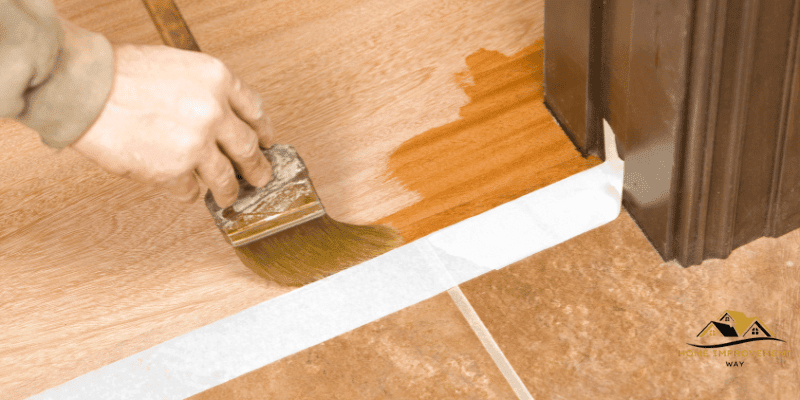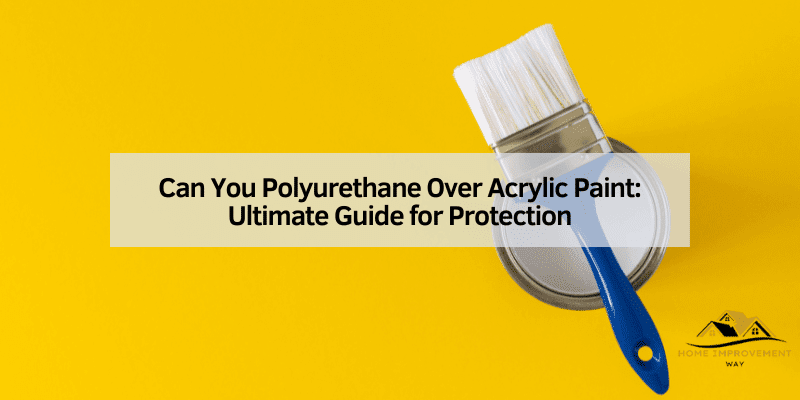Yes, you can polyurethane over acrylic paint. You should wait for the paint to cure.
Applying polyurethane over acrylic paint can provide extra protection and a glossy finish to your project. Many DIY enthusiasts use this method to enhance their paintings, furniture, or other crafts. However, it’s important to follow the proper process and allow the acrylic paint to fully dry and cure before applying polyurethane.
This ensures a durable and long-lasting finish. We will cover the steps and considerations for successfully applying polyurethane over acrylic paint, as well as the benefits of doing so. Whether you’re a seasoned artist or a beginner looking to elevate your project, understanding this process can help you achieve professional-quality results.
Interpretation Acrylic Paint And Polyurethane
Acrylic Paint is a water-based paint that is known for its quick drying time and versatility. It can be used on various surfaces and provides a smooth, matte finish. On the other hand, Polyurethane is a protective finish that is typically used to coat wood surfaces. It is known for its durability and can provide a glossy or satin finish. The main difference lies in their composition and the surfaces they are best suited for.
While polyurethane is commonly used over acrylic paint to provide a protective layer, it is important to ensure compatibility between the two. Generally, polyurethane can be applied over acrylic paint with proper surface preparation. This includes ensuring that the acrylic paint is fully cured and free of any contaminants before applying the polyurethane. It’s also essential to use a water-based polyurethane for the best adhesion over acrylic paint.
Preparing Acrylic Paint For Polyurethane Application
When aiming to protect and enhance the appearance of your acrylic paint, applying polyurethane is a favorable option. Polyurethane can provide a durable and glossy finish, augmenting the longevity and vibrancy of your acrylic artwork. However, prior to the application of polyurethane over acrylic paint, meticulous preparation is crucial. This process involves surface preparation, cleaning, and sanding to ensure the best results.
Surface Preparation For Polyurethane Application
Before proceeding with the polyurethane application, it’s essential to prepare the surface of the acrylic paint. Ensure that the painted surface is clean, smooth, and free from imperfections to achieve an impeccable finish. Kickstart the process by examining the surface for any irregularities or contaminants. Use a lint-free cloth to wipe away any dust, dirt, or debris that may impede the adhesion of the polyurethane.
Importance Of Proper Cleaning And Sanding
Effective cleaning and sanding play a pivotal role in ensuring the success of the polyurethane application. Thorough cleaning of the painted surface is essential to remove any grease, oils, or residues that could compromise the adhesion. Utilize a gentle cleaner and a soft cloth to meticulously clean the surface. Once the surface is clean, proceed to sand it lightly with fine-grit sandpaper. Sanding helps to create a textured surface, improving the bond between the acrylic paint and the subsequent polyurethane coating.

Applying Polyurethane Over Acrylic Paint
When it comes to protecting and enhancing the longevity of your acrylic paint projects, applying polyurethane can be an effective solution. However, it’s essential to understand the right type of polyurethane to choose and the proper application methods to ensure the best results.
Choosing The Right Type Of Polyurethane
Polyurethane comes in different forms, including water-based and oil-based options. For applying over acrylic paint, it’s recommended to opt for a water-based polyurethane as it dries faster and is less likely to yellow over time. Additionally, ensure that the polyurethane is labeled as ‘clear’ to maintain the vibrancy and clarity of the acrylic paint underneath.
Application Methods And Techniques
Before applying polyurethane over acrylic paint, ensure that the paint has fully dried and cured, usually waiting at least 24-48 hours. When ready to apply, use a high-quality synthetic brush or a foam applicator to achieve a smooth and even coat. Make sure to apply thin, even layers of polyurethane, allowing each coat to dry thoroughly before applying the next. Sanding lightly between coats can also help achieve a smoother finish.
Curing And Protecting Acrylic Paint With Polyurethane
When it comes to protecting and preserving your acrylic paint projects, polyurethane can play a crucial role. Understanding the curing process and how polyurethane can provide long-term protection and maintenance for acrylic paint is essential for achieving lasting and impactful results.
Understanding The Curing Process
Acrylic paint dries quickly, but curing, a chemical process that hardens and fully adheres the paint to the surface, takes longer. Curing typically takes around two weeks, but can vary based on factors like temperature and humidity. It’s important to allow the paint to fully cure before applying any additional finishes, such as polyurethane, to ensure a strong bond and prevent any potential issues with adhesion.
Long-term Protection And Maintenance
Once the acrylic paint has fully cured, applying a coat of polyurethane can provide a durable and protective finish. Polyurethane acts as a barrier against moisture, UV rays, and general wear and tear, extending the life and vibrancy of the acrylic paint. It also offers ease of maintenance, as it can be wiped clean and provides a smooth, glossy or matte finish, enhancing the visual appeal of the artwork or project.
Ensuring Durability And Longevity Of Acrylic Paint With Polyurethane
Acrylic paint is a versatile and popular medium for artists and DIY enthusiasts. Yet, to ensure its long-lasting beauty and protection against wear and tear, applying a layer of polyurethane over acrylic paint can make a significant difference. By understanding the benefits of polyurethane and practicing proper care and maintenance, you can enhance the durability of your acrylic paint projects and extend their longevity.
Benefits Of Using Polyurethane For Protection
Polyurethane serves as a robust protective layer over acrylic paint, guarding it against scratches, fading, and moisture damage. It provides a hard and resilient finish that can withstand everyday use, making it especially suitable for painted surfaces that are frequently touched or exposed to the elements. The glossy or matte finish options available in polyurethane also allow you to customize the look of your acrylic paint projects, offering both protection and aesthetic appeal.
Proper Care And Maintenance For Long-lasting Results
Once you’ve applied polyurethane over acrylic paint, proper care and maintenance are essential for preserving the quality of the finish. Regular cleaning with a mild detergent and soft cloth can help remove dirt and grime without damaging the protective layer. Avoid using harsh abrasives or solvents that could compromise the integrity of the polyurethane. Additionally, be mindful of avoiding prolonged exposure to direct sunlight or extreme temperature changes, as these factors can affect the longevity of the protective coating. By taking these measures, you can ensure that your acrylic paint projects maintain their beauty and durability over time.
Frequently Asked Questions For Can You Polyurethane Over Acrylic Paint
Can You Apply Polyurethane Over Acrylic Paint?
Yes, you can apply polyurethane over acrylic paint. Ensure the acrylic paint is completely dry and follow proper surface preparation and application methods for the best results. Polyurethane provides a protective and durable finish over the acrylic paint.
What Are The Benefits Of Applying Polyurethane Over Acrylic Paint?
Applying polyurethane over acrylic paint can provide added protection, durability, and a glossy finish. It helps to prevent chipping, fading, and damage to the underlying acrylic paint layer. Additionally, polyurethane can enhance the aesthetic appearance of the painted surface.
How Long Should Acrylic Paint Dry Before Applying Polyurethane?
It is recommended to allow acrylic paint to dry for at least 24 hours before applying polyurethane. However, the specific drying time may vary based on the type of acrylic paint, thickness of application, and environmental conditions. Ensure the paint is fully cured before applying polyurethane.
Can You Use A Water-based Polyurethane Over Acrylic Paint?
Yes, water-based polyurethane can be used over acrylic paint. It is important to ensure that the acrylic paint is completely dry before applying the water-based polyurethane. Follow the manufacturer’s instructions for proper application and ensure compatibility between the paint and polyurethane products.
Conclusion
You can polyurethane over acrylic paint to protect and add durability to your project. It’s important to properly prepare the surface and follow the recommended application process for best results. By understanding the compatibility and taking necessary precautions, you can achieve a smooth and lasting finish for your painted surfaces.


